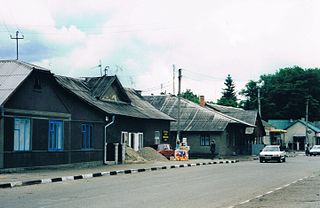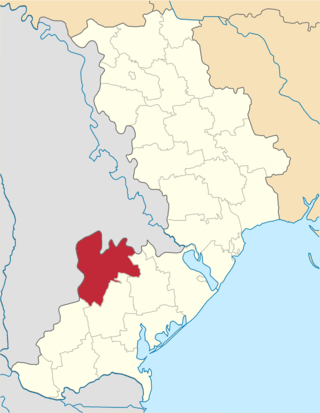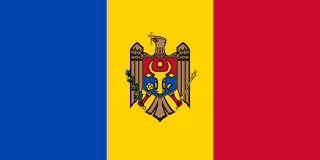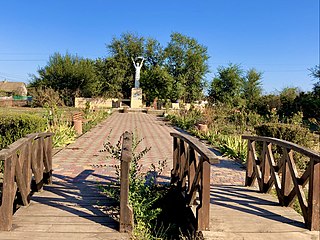The Gagauz are a Turkic ethnic group native to southern Moldova and southwestern Ukraine (Budjak). Gagauz are mostly Eastern Orthodox Christians. The term Gagauz is also often used as a collective naming of Turkic people living in the Balkans, speaking the Gagauz language, a language separated from Balkan Gagauz Turkish.

Bilhorod-Dnistrovskyi, historically known as Aq Kirmān or by other names, is a port city in Odesa Oblast, southwestern Ukraine. It is situated on the right bank of the Dniester Estuary leading to the Black Sea, in the historical region of Budjak. It also serves as the administrative center of Bilhorod-Dnistrovskyi Raion and is coterminous with Bilhorod-Dnistrovskyi urban hromada, one of the hromadas of Ukraine. It is the location of a large freight seaport. Population: 47,727.

Budjak, also known as Budzhak, is a historical region that was part of Bessarabia from 1812 to 1940. Situated along the Black Sea, between the Danube and Dniester rivers, this multi-ethnic region covers an area of 13,188 km2 (5,092 sq mi) and is home to approximately 600,000 people. The majority of the region is now located in Ukraine's Odesa Oblast, while the remaining part is found in the southern districts of Moldova. The region is bordered to the north by the rest of Moldova, to the west and south by Romania, and to the east by the Black Sea and the rest of Ukraine.

Reni is a small city in Izmail Raion, Odesa Oblast, southern Ukraine. It hosts the administration of Reni urban hromada, one of the hromadas of Ukraine. Reni is located in the Bessarabian historic district of Budjak and on the left bank of the Danube. The settlement was founded around 1548, acquiring city status in 1821. Population: 17,736.

Reni Raion was a raion (district) in Odesa Oblast in south-western Ukraine, in the historic Budjak region of Bessarabia. Its administrative center was the city of Reni. The raion was abolished on 18 July 2020 as part of the administrative reform of Ukraine, which reduced the number of raions of Odesa Oblast to seven. The area of Reni Raion was merged into Izmail Raion, but the Reni urban hromada has the same territory as the old Reni Raion. The last estimate of the raion population was 36,117. In 2001, population was 40,680.

Hertsa or Hertza is a town located in Chernivtsi Raion, Chernivtsi Oblast in western Ukraine and has a population of 2,097.

The Bessarabian Bulgarians are a Bulgarian minority group of the historical region of Bessarabia, inhabiting parts of present-day Ukraine and Moldova.
This article represents an overview on the history of Romanians in Ukraine, including those Romanians of Northern Bukovina, Zakarpattia, the Hertsa region, and Budjak in Odesa Oblast, but also those Romanophones in the territory between the Dniester River and the Southern Buh river, who traditionally have not inhabited any Romanian state, but have been an integral part of the history of modern Ukraine, and are considered natives to the area. There is an ongoing controversy whether self-identified Moldovans are part of the larger Romanian ethnic group or a separate ethnicity. A large majority of the Romanian-speakers living in the former territories of Bukovina and Hertsa region, as well as in Transcarpathia, consider themselves to be ethnic Romanians, but only a minority of those in the historical province of Bessarabia, and the areas further to the east, do. There was a significant decrease in the number of individuals who identified themselves as ethnic Moldovans in the 1989 Soviet census, and a significant increase in the number of self-identified ethnic Romanians, especially, but not exclusively, in northern Bukovina and the Hertsa area according to the 2001 Ukrainian census.

Artsyz is a city in Bolhrad Raion of Odesa Oblast, Ukraine. It hosts the administration of Artsyz urban hromada, one of the hromadas of Ukraine. Population: 14,355. In 2001, population was 16,370. In 2001, the city of Artsyz was 66.51% Russian-speaking, 22.57% Ukrainian-speaking, 7.9% Bulgarian-speaking, and 1.49% Romanian-speaking. The city had 16,268 inhabitants in 2001, of which 6,495 identified themselves as ethnic Ukrainians (39.92%), 5,258 as ethnic Russians (32.32%), 3,075 as Bulgarians (18.90%), 695 as Moldovans (4.27%) and 204 (1.25%),as Gagauz.

Novoselytsia is a city in Chernivtsi Raion, Chernivtsi Oblast (province) of Ukraine. It stands at the northern tip of Bessarabia region, on its border with Bukovina. It hosts the administration of Novoselytsia urban hromada, one of the hromadas of Ukraine. Population: 7,399.

Novoselytsia Raion was a raion in Chernivtsi Oblast, (province) in the west of Ukraine. The western part of its territory lied in the historical region of Bukovina, the eastern part in Bessarabia, while one village (Boianivka) was part of the Hertsa region. The center of the raion was the city of Novoselytsia. The raion was abolished on 18 July 2020 as part of the administrative reform of Ukraine, which reduced the number of raions of Chernivtsi Oblast to three. The area of Novoselytsia Raion was split between Chernivtsi and Dnistrovskyi Raions. The last estimate of the raion population was 76,744

Tarutyne Raion was a raion in Odesa Oblast in southwestern Ukraine. It was in the historical region of Budjak in southern Bessarabia and its administrative seat was Tarutyne. The raion was abolished on 18 July 2020 as part of the administrative reform of Ukraine, which reduced the number of raions of Odesa Oblast to seven. The area of Tarutyne Raion was merged into Bolhrad Raion. The last estimate of the raion population was 40,054.

The Georgi Sava Rakovski Bolhrad High School is a gymnasium in Bolhrad, Odesa Oblast, southwestern Ukraine. Founded in 1858 at the request of Bolhrad's Bessarabian Bulgarian population, the Bolhrad Gymnasium is regarded as the oldest high school of the Bulgarian National Revival.
Russians in Moldova form the second largest ethnic minority in the country. According to the Moldovan Census (2004) and a separate 2004 Census in Transnistria, about 370,000 persons identified themselves as ethnic Russians in Moldova.

Ismail County was a county (județ) of Romania between 1925 and 1938 and between 1941 and 1944, in Bessarabia, with the capital city at Ismail. It was also a county of Moldavia between 1856 and 1859, and of the Principality of Romania between 1859 and 1878, in Southern Bessarabia.

Artsyz Raion was a raion (district) in Odesa Oblast of Ukraine. It was part of the historical region of Bessarabia. Its administrative center was the city of Artsyz. The raion was abolished on 18 July 2020 as part of the administrative reform of Ukraine, which reduced the number of raions of Odesa Oblast to seven. The area of Artsyz Raion was merged into Bolhrad Raion. According to the 2001 census, there population was composed of speakers of Russian (42.79%), Bulgarian (33.98%), Ukrainian (18.24%), Romanian (3.08%) and Gagauz (0.83%). The last estimate of the raion population was 45,774.
Mahala is a village in Chernivtsi Raion, Chernivtsi Oblast, Ukraine with a predominantly romanian population. It hosts the administration of Mahala rural hromada, one of the hromadas of Ukraine.

Moldovans in Ukraine are the third biggest minority recorded in the 2001 All Ukrainian Census after Russians and Belarusians. Unlike many other minorities, Moldovans often live in the countryside (71.5%) rather than in a city (28.5%), the majority in the northern and southern historical region of Bessarabia. There is an undergoing identity controversy among the Romanian speakers of Ukraine over whether self-identified Moldovans are a part of the larger Romanian ethnic group or a separate ethnic group.

Krasne is a village in the Odesa Oblast, Ukraine, with about 1,300 inhabitants (2001). It belongs to Tarutyne settlement hromada, one of the hromadas of Ukraine.
Reni urban hromada is a hromada (municipality) in Ukraine, in Izmail Raion of Odesa Oblast. The administrative center is the city of Reni. Population: 35,156
























